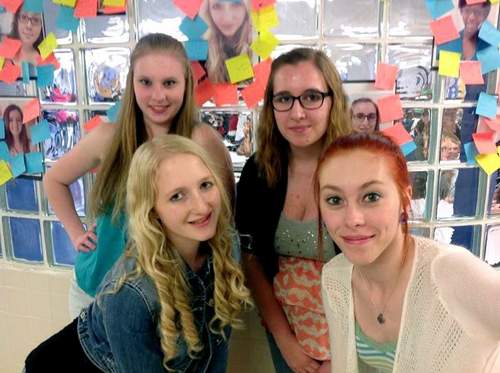By Katherine Clark
Watertown Daily Times, N.Y.
PHILADELPHIA
More than 20 Indian River Central High School students hung pictures exposing their least favorite qualities for their classmates to critique.
The revealing series of selfies shows true beauty isn’t defined by Barbie or edited photos, but by embracing what real women embody.
“The idea was to break the myth of the ideal beauty,” sophomore Josephine R. Compeau said. “We embraced our imperfections and we found they weren’t imperfections at all.”
A “selfie” is defined by the Oxford dictionary as a “photograph that one has taken of oneself.”
The selfie project was done through the Current Health Issues class with Josephine, junior Catelynn L. Phillips, senior Jenni L. Getman and junior Abagail J. Pedroza.
During a presentation introducing the project May 29, Josephine said the first selfie was taken in 1839 by Robert Cornelius.
Since then the selfie has become easier than ever to take with digital cameras on smartphones and tablets. With applications such as Instagram, those photos can be easily edited and posted on the Internet.
The project was inspired by the Dove company’s Campaign for Real Beauty. The students asked girls from their high school to submit photos of themselves that were unedited.
On Monday during lunch period, the 25 photos of students and some of their mothers were hung outside the school cafeteria. Their classmates were able to leave comments on pieces of paper and attach them to the pictures.
The photos revealed different things the girls were self conscious about. One student took a picture with her hair down and curly. Another girl showed off her dimples.
Another student allowed her shoulders to be in the picture, and another took a photo with her glasses on. Josephine said some of the comments complimented what the girls were afraid to show.
Josephine said she was nervous to post a picture of herself. She said she’s always been self-conscious that one of her eyes is bigger than the other. For her photo, she didn’t turn her head. At the end of the lunch period there were comments left that said she had beautiful eyes.
A yellow note proclaimed another student looked like “a precious looking Disney princess #flawless.”
Indian River health teacher Stacy L. Cavellier said high school students are used to looking at the selfies posted on their friends’ Facebook wall and Instagram feeds.
Catelynn said the photos were just one exercise to show that girls and women should be proud of their features instead of trying to alter them with makeup or photo filters.
“We wanted to pursue this to show how society portrays beauty is wrong,” Catelynn said. “We wanted to show them everyone is beautiful in their own way.”
The four girls recruited other girls through an informational session after school and by going into health classes.
“Everyone takes selfies, and we know to stand a certain way or angle the camera in a certain direction,” Josephine said. “We position ourselves just right to avoid showing what we don’t want to be seen.”
One girl was brought to tears seeing the positive comments people wrote on notes and stuck to her photo.
“It impacted the way they see themselves,” Josephine said.
In the forum May 29, one of the first lessons they went over was that a beloved childhood icon was only a toy, not an ideal to embody.
“Barbies are not real,” Josephine said. She and her fellow students used the topic of Barbie to address the unrealistic and unattainable standards of beauty set by magazines, photo editing software and the seemingly innocent dolls played with by millions of children every year.
Angie M. Foster, regional youth coordinator for ACR Health, said the Barbie with tall slender body, large breasts and tiny waist creates a distorted image of the perfect body.
“We’re not picking on Barbie, but girls are exposed to Barbie at a young age,” Ms. Foster. “We’re picking on the way the way we perceive self images.”
Another tool used was a time-lapse video that begins with a model sitting down to have her hair and makeup done. The video shows how her image is distorted through lighting techniques and then through photo editing technology.
“In England they won’t even use American advertisements that have been edited like this,” Ms. Foster said, “because as you can see it doesn’t even look like the same person.”
Josephine said the project got so many people talking at school that the students hope to have another project for their male classmates.
“There were a lot of boys interested in getting involved,” she said. “More focused on their behavior; people always tell them to be tough and be a man.”
The selfie project also could head to the middle school to take the same lessons about beauty to younger girls.
Ms. Cavellier said it was “neat” to watch the selfie project evolve to include so many students and inspire positive dialogue.














































































































































































































































































































































































